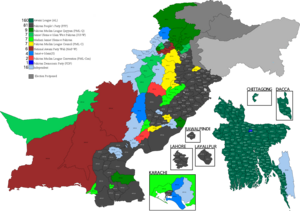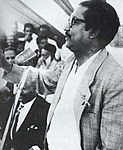| ||||||||||||||||||||||
300 of the 313 seats in the National Assembly 151 seats needed for a majority | ||||||||||||||||||||||
|---|---|---|---|---|---|---|---|---|---|---|---|---|---|---|---|---|---|---|---|---|---|---|
| Registered | 56,941,500 | |||||||||||||||||||||
| Turnout | 57.96% | |||||||||||||||||||||
| ||||||||||||||||||||||
 Results by constituency | ||||||||||||||||||||||
| ||||||||||||||||||||||
| Independence of Bangladesh |
|---|
 |
| Events |
| Organisations |
| Key persons |
| Related |
|
|
| History of Bangladesh |
|---|
 |
|
|
General elections were held in Pakistan on 7 December 1970 to elect members of the National Assembly. They were the first direct general elections since the independence of Pakistan and ultimately the only ones held prior to the independence of Bangladesh. Voting took place in 300 general constituencies, of which 162 were in East Pakistan and 138 in West Pakistan. A further thirteen seats were reserved for women (seven of which were in East Pakistan and six of which were in West Pakistan), who were to be elected by members of the National Assembly.[1]
The elections were a fierce contest between two social democratic parties, the west-based Pakistan Peoples Party (PPP) and the east-based All-Pakistan Awami League. The Awami League was the sole major party in the east wing, while in the west wing, the PPP faced severe competition from the conservative factions of Muslim League, the largest of which was Muslim League (Qayyum), as well as Islamist parties like Jamaat-e-Islami (JI), Jamiat Ulema-e-Islam (JUI) and Jamiat Ulema-e-Pakistan (JUP).
The result was a victory for the Awami League, which gained an absolute majority, winning 160 of the 162 general seats and all seven women's seats in East Pakistan. The PPP won only 81 general seats and five women's seats, all in West Pakistan. In the provincial elections held ten days later, the Awami League again dominated in East Pakistan, while the PPP were the winning party in Punjab and Sindh. The Marxist National Awami Party emerged victorious in Northwest Frontier Province and Balochistan.
The National Assembly was initially not inaugurated as President Yahya Khan and the PPP chairman Zulfikar Ali Bhutto did not want a party from East Pakistan in federal government.[2] Instead, Yahya appointed the veteran Bengali politician Nurul Amin as Prime Minister, asking him to reach a compromise between the PPP and Awami League. However, this move failed as the delay in inauguration had already caused significant unrest in East Pakistan. The situation deteriorated further when Operation Searchlight occurred under the orders of Yahya resulting in a civil war that led to the formation of the independent state of Bangladesh.[3] The Assembly was eventually inaugurated in 1972 after Yahya resigned and handed power to Zulfikar Ali Bhutto. Bhutto became Prime Minister in 1973 after the post was recreated by a new constitution.
- ^ Craig Baxter (1971). "Pakistan Votes -- 1970". Asian Survey. 11 (3): 197–218. doi:10.2307/3024655. ISSN 0004-4687. JSTOR 3024655.
- ^ "1970 polls: When election results created a storm". Dawn. 8 January 2012.
- ^ "History: Bhutto, Mujib and the generals". Dawn. 4 May 2019.

